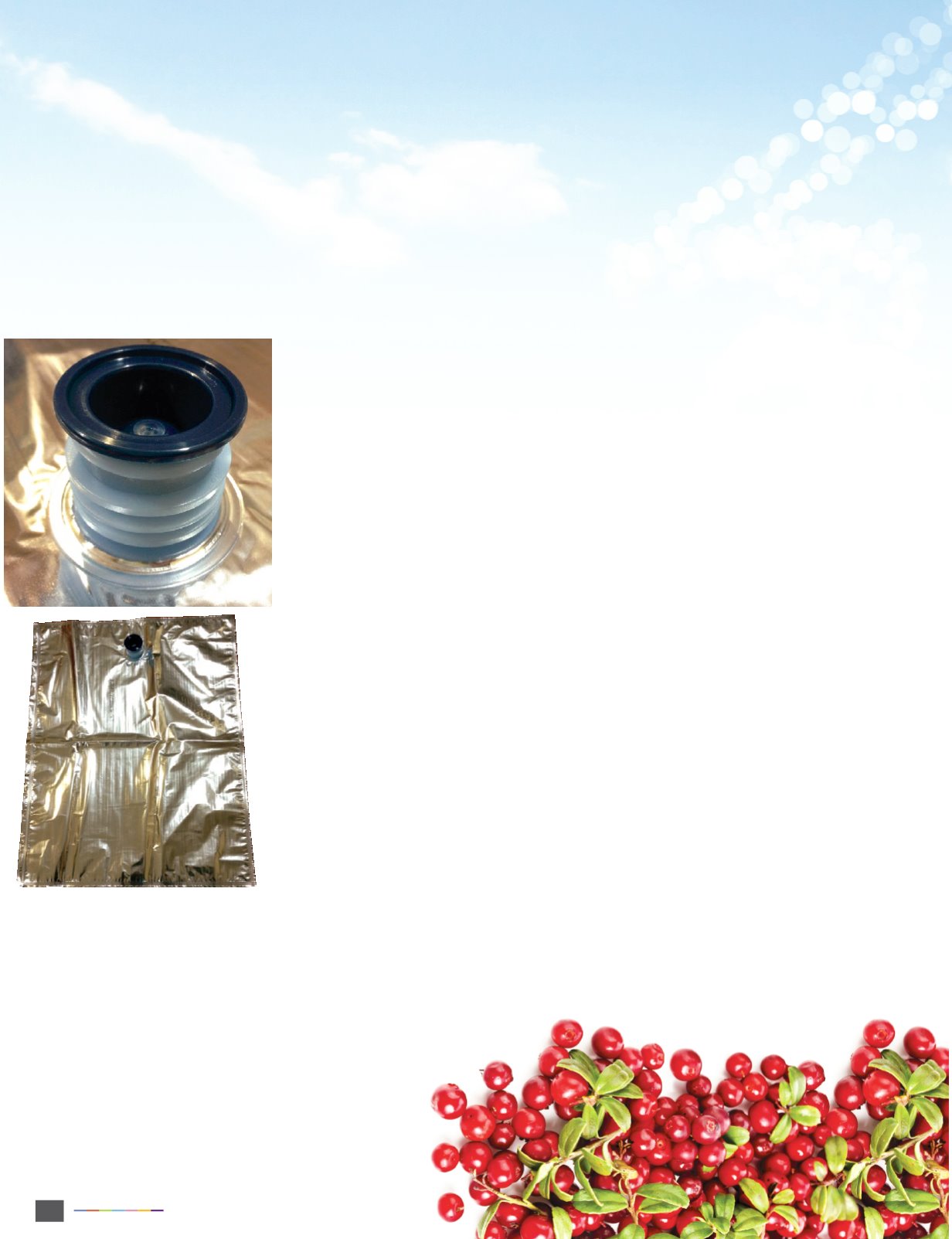
Food Focus Thailand
JUNE 2013
56
การบรรจุ
วั
ตถุ
ดิ
บน้
ำผลไม
เข
มข
นลงในถุ
งปลอดเชื้
อซึ่
งทำหน
าที่
ป
องกั
นการปนเป
อนเชื้
อจุ
ลิ
นทรี
ย
สิ่
งแปลกปลอม และสารเคมี
จาก
ภายนอก เนื่
องจากฝาป
ดของถุ
งปลอดเชื้
อนี้
ถู
กออกแบบมาให
ใช
กั
บ
เครื่
องบรรจุ
เพื่
อป
ดฝาหลั
งจากบรรจุ
เสร็
จแล
วเท
านั้
น และ
ไม
สามารถใช
วิ
ธี
ใดเป
ดฝาออกได
อี
ก เพื่
อยื
นยั
นความปลอดภั
ย
แก
ลู
กค
าว
าบรรจุ
ภั
ณฑ
นี้
ถู
กผลิ
ตและส
งถึ
งมื
อลู
กค
าโดยตรงอย
าง
ปลอดภั
ย ไม
เคยถู
กเป
ดออก และ/หรื
อมี
สิ่
งปลอมปนอั
นใดก
อนถึ
งมื
อ
ลู
กค
า ซึ่
งวิ
ธี
การเดี
ยวที่
จะเป
ดบรรจุ
ภั
ณฑ
นี้
ออกได
คื
อ การตั
ดถุ
ง
ปลอดเชื้
อนี้
โดยลู
กค
าเอง แต
หากลู
กค
าพบการรั่
วซึ
มจากภายในสู
ภายนอกแล
วให
ถื
อว
าสิ
นค
านั้
นชำรุ
ด และไม
ปลอดภั
ยต
อการนำมา
ใช
อี
กต
อไป
ชนิ
ดของถุ
งปลอด-
เ ชื้
อ ซึ่
ง วั
สดุ
ผ ลิ
ต จ า ก
อะลู
มิ
เนี
ยมฟอย
ลผ
าน
ก ร ะ บ ว น ก า ร ฆ
า เ ชื้
อ
ส เ ต อ ริ
ไ ร ซ
แ ล
ว นั้
น
ส า ม า ร ถ ยื
น ยั
น
คุ
ณสมบั
ติ
การปลอดเชื้
อ
ซึ่
งพร
อมใช
งานได
ทั
นที
มี
คุ
ณลั
กษณะทึ
บแสง
รวมถึ
งป
องกั
นอากาศ
(ออกซิ
เจน) ภายนอก
ถุ
ง สั
ม ผั
ส กั
บ วั
ต ถุ
ดิ
บ
น้
ำผลไม
เข
มข
นที่
บรรจุ
ไว
ภายใน จึ
งช
วยป
องกั
น
การเกิ
ดปฏิ
กิ
ริ
ยาออก-
ซิ
เดชั่
นอี
กด
วย ซึ่
งสิ่
งนี้
มี
ผ ล กั
บ ม า ต ร ฐ า น
คุ
ณภาพโดยรวมของ
น้
ำ ผล ไ ม
เ ข
มข
น เ ป
น
อย
า ง มา ก โ ดยช
ว ย
รั
กษาคุ
ณลั
กษณะของ
น้
ำผลไม
ในด
านสี
กลิ่
น
รสชาติ
และรสสั
มผั
ส
ให
คงที่
ไม
เพี้
ยนไปจากเดิ
มมากนั
ก และช
วยลดการเสื่
อมสลายของ
สารอาหารตามอายุ
ผลิ
ตภั
ณฑ
ทั้
งนี้
คุ
ณลั
กษณะเด
นของถุ
งชนิ
ดนี้
ยั
งช
วยป
องกั
นการเจื
อปนของกลิ่
นจากภายนอกได
ดี
อี
กด
วย
หลั
งจากเครื่
องจั
กรบรรจุ
วั
ตถุ
ดิ
บน้
ำผลไม
เข
มข
นลงสู
ถุ
งปลอดเชื้
อ
แล
ว ระบบจะลำเลี
ยงถุ
งที่
ป
ดฝาสนิ
ทแล
วไปบนสายพานของ
เครื่
องจั
กรเพื่
อเข
าสู
กระบวนการฆ
าเชื
้
อบริ
เวณภายนอกถุ
งด
วยไอน้
ำ
ร
อนเป
นครั้
งสุ
ดท
ายก
อนบรรจุ
ลงในถั
งปลอดเชื้
อ และจั
ดเก็
บเพื่
อ
เตรี
ยมจั
ดส
งแก
ลู
กค
าต
อไป
depending on the acidity level of each fruit. Any fruit juices with pH higher
than 3.9, the recommended heat is at 106
ํ
C to 114
ํ
C for 10-30 seconds,
while acidic fruit juices with pH lower than 3.9, the recommended heat is
at 95
ํ
C to 105
ํ
C for 10-30 seconds, because acidity level in fruit juices
inhibits the growth of pathogenic organisms, so less heat is applied to
more acidic fruit juices to preserve pleasant sensory profiles in the finished
product. After heat treatment, the fruit juices will be cooled down to
20
ํ
C to 25
ํ
C before filling into aseptic bag, then after packing aseptic bag
into aseptic drum, it is stored at 0
ํ
C to 5
ํ
C and ready to be distributed.
These pasteurization process and temperature control storage allow a
standard shelf life of 1 year with high quality and less loss of vitamins and
minerals in fruit juices.
Note:
Sterilization at high heat and/or extended length of time can
damage the physical and sensory profiles of natural fruit juices, also cause
loss of most nutrients.
Aseptic bag prevents contamination of external microorganism, foreign
matters, and chemicals. The safety cap of aseptic bag is designed to be
closed once and by a machine only with the main purpose to ensure the
customers that the product packed in an aseptic bag is safely sealed and
not tampered by anything and/or anyone else during transportation and/
or transaction of the product. The only way to open an aseptic bag is by
cutting it, but if the customer finds any leak of liquid inside into outside,
then it is unfit and unsafe to use that leak aseptic bag and its fruit juices
inside anymore.
Aseptic bag which is made of aluminum foil is sterilized and safe to
use instantly. Its opaque and oxygen barrier quality ensure anti-oxidation,
maintain good sensory profiles, reduce the loss of nutrients in fruit juices,
promote product’s standard shelf life, and avoid contamination of external
smell to penetrate inside the bag.
After filling fruit juices into an aseptic bag, then the bag is carried onto
the next assembly line toward high temperature water bath by hot steam
and then into aseptic drum.
Aseptic Packing VS Frozen Packing
In fruit juice concentrate industry, there are 2 ways of packing, the first is
aseptic packing and the second is frozen packing for which is not treated
by heat during the production and packing process, but instead by a
very low temperature at -18
ํ
C to freeze the growth of microorganism
temporarily. This way offers more flavorful fruit juice concentrates, but
common complaints are the presence of microorganism, inconveniences
of more work and time required for thawing the frozen form of fruit juice
concentrate into liquid form before using it in the production line of food &
beverage finished products, also the cost of storing the frozen fruit juice
concentrate at -18
ํ
C is inevitable (to prevent growth of microorganism) and
much higher, comparing to the aseptic pack one. Due to the fact that aseptic
fruit juice concentrates, which is produced by thermal concentration; as a
result of utilizing heat to evaporate water out of natural fruit juices, offers


